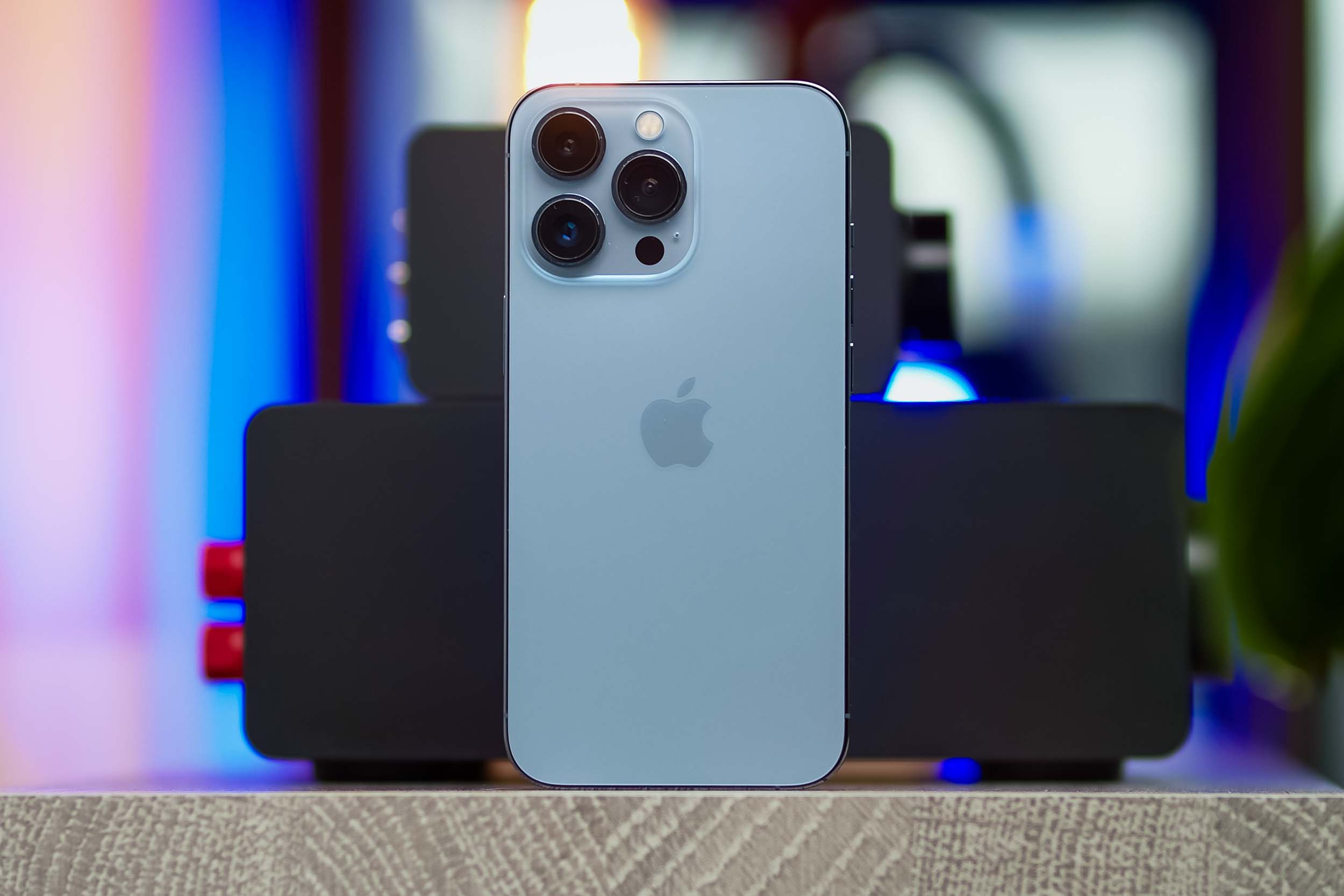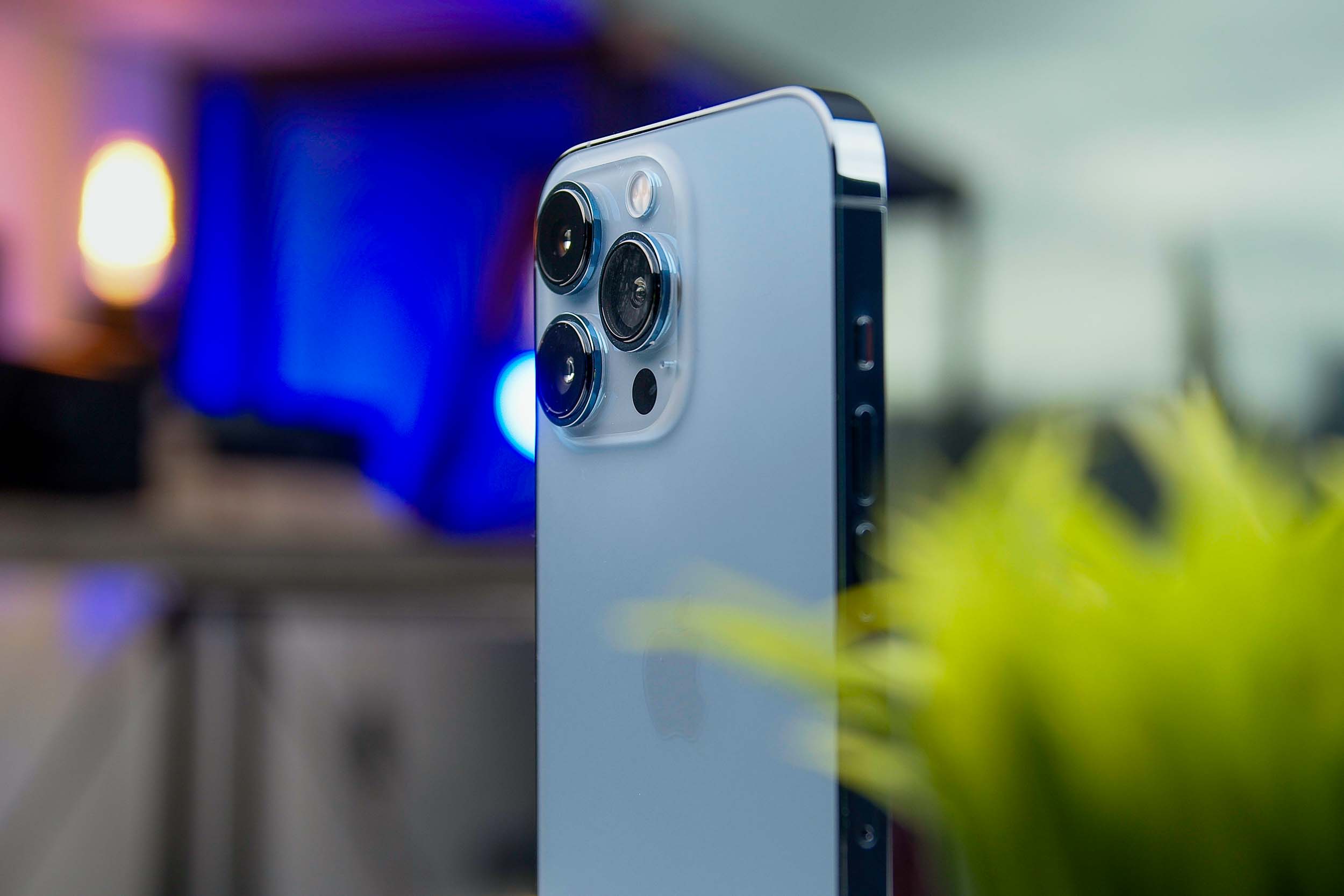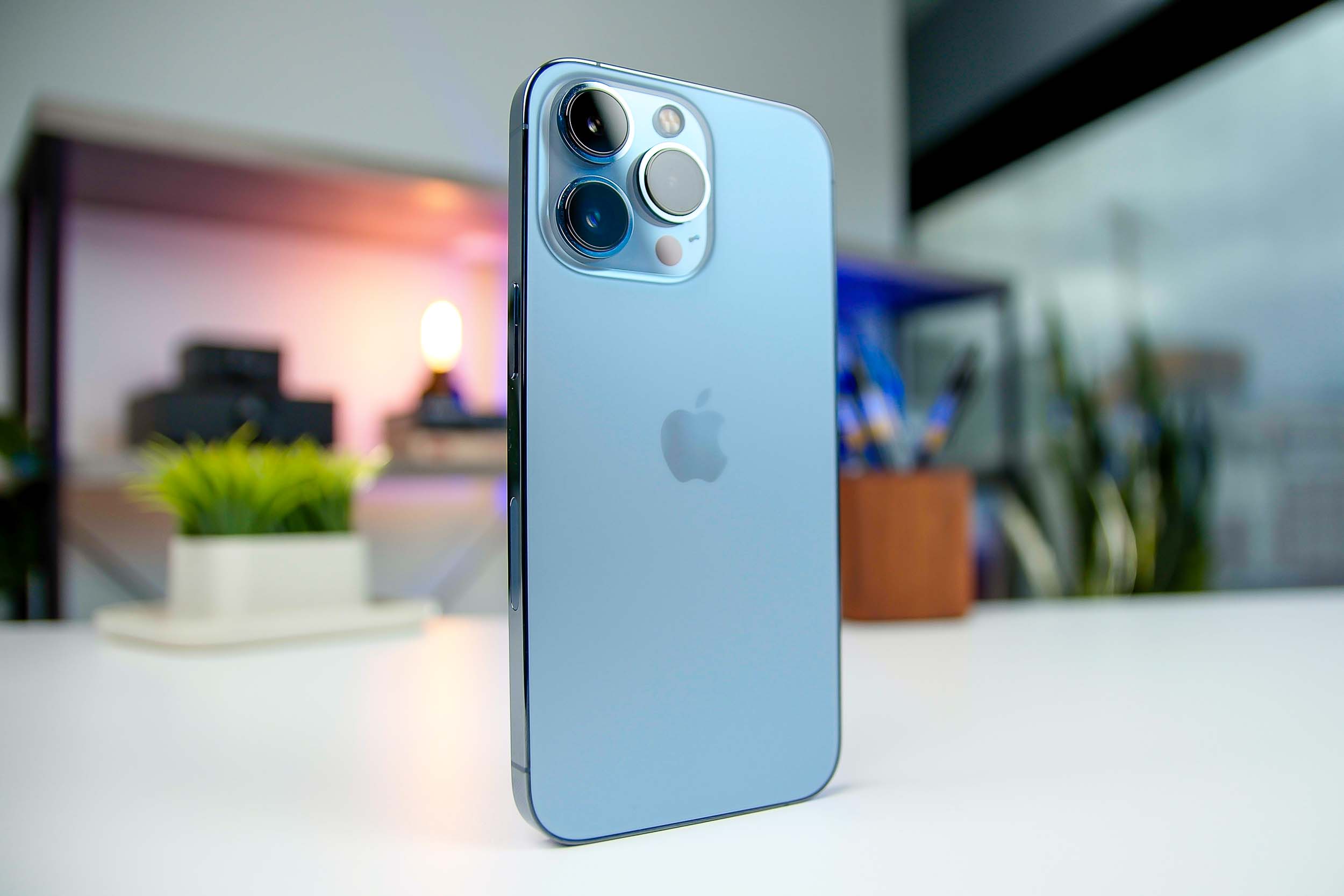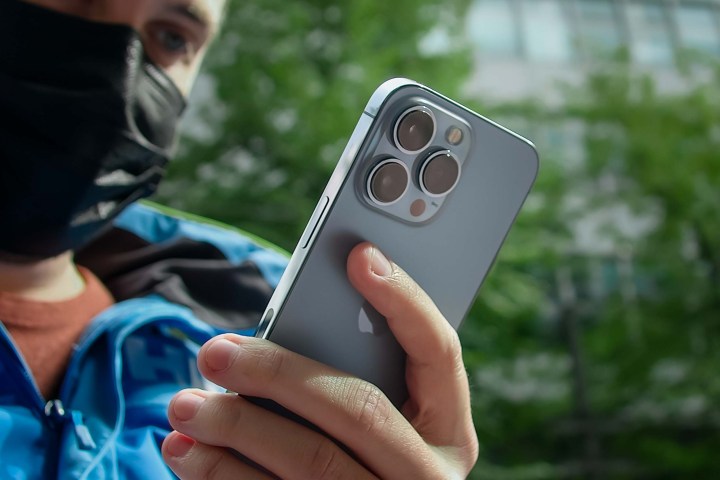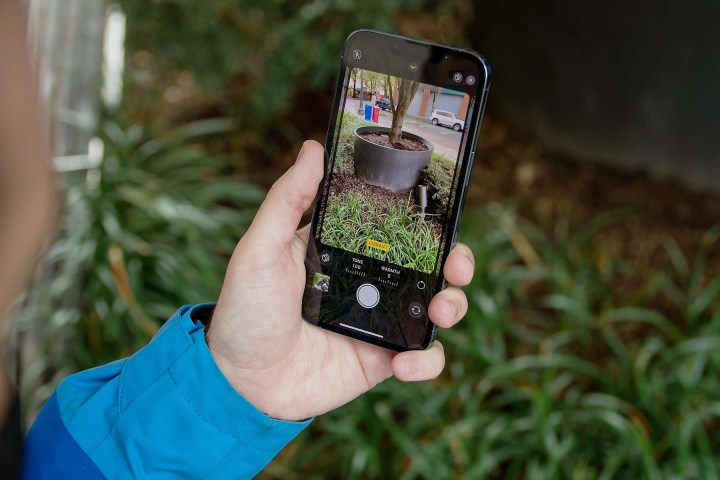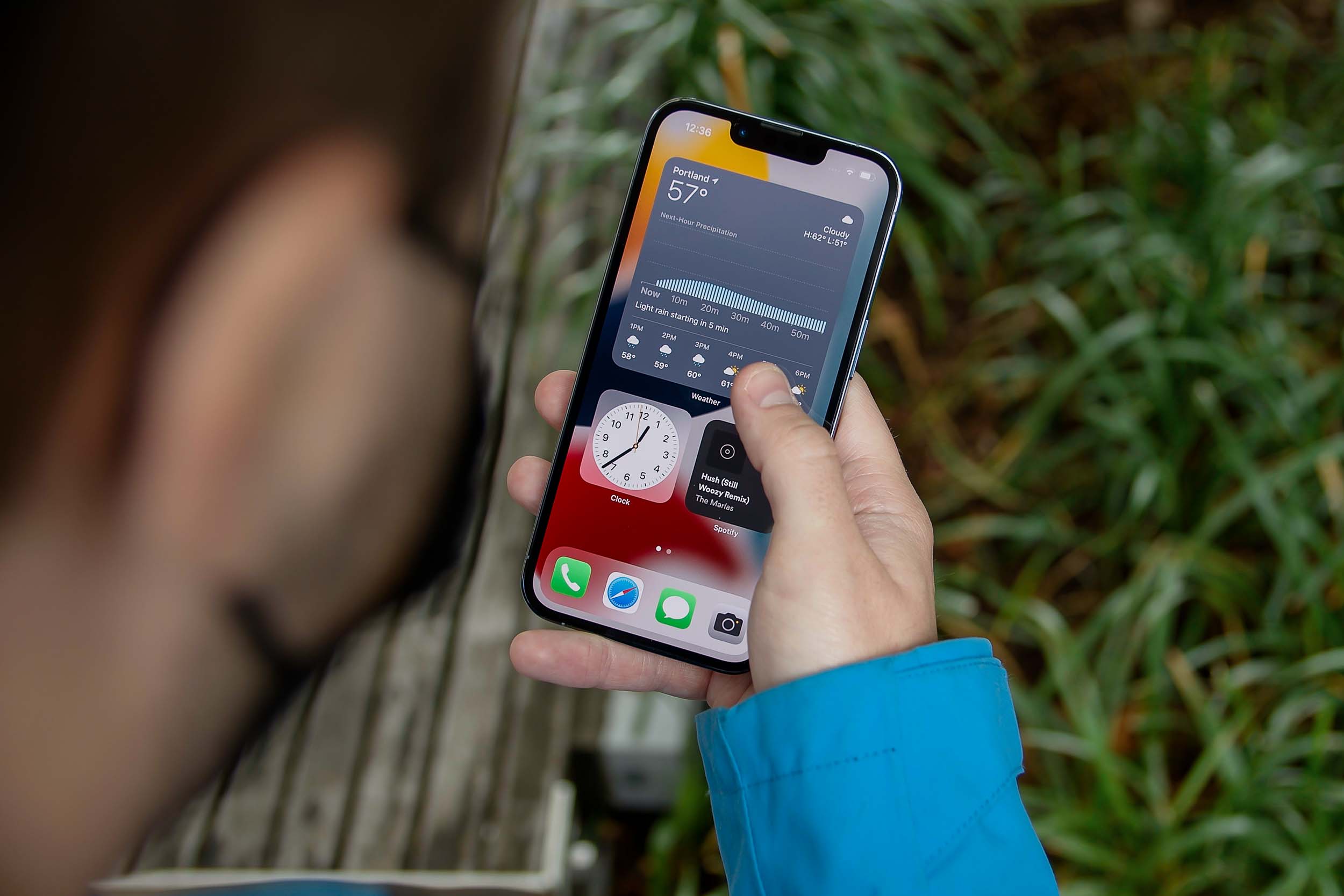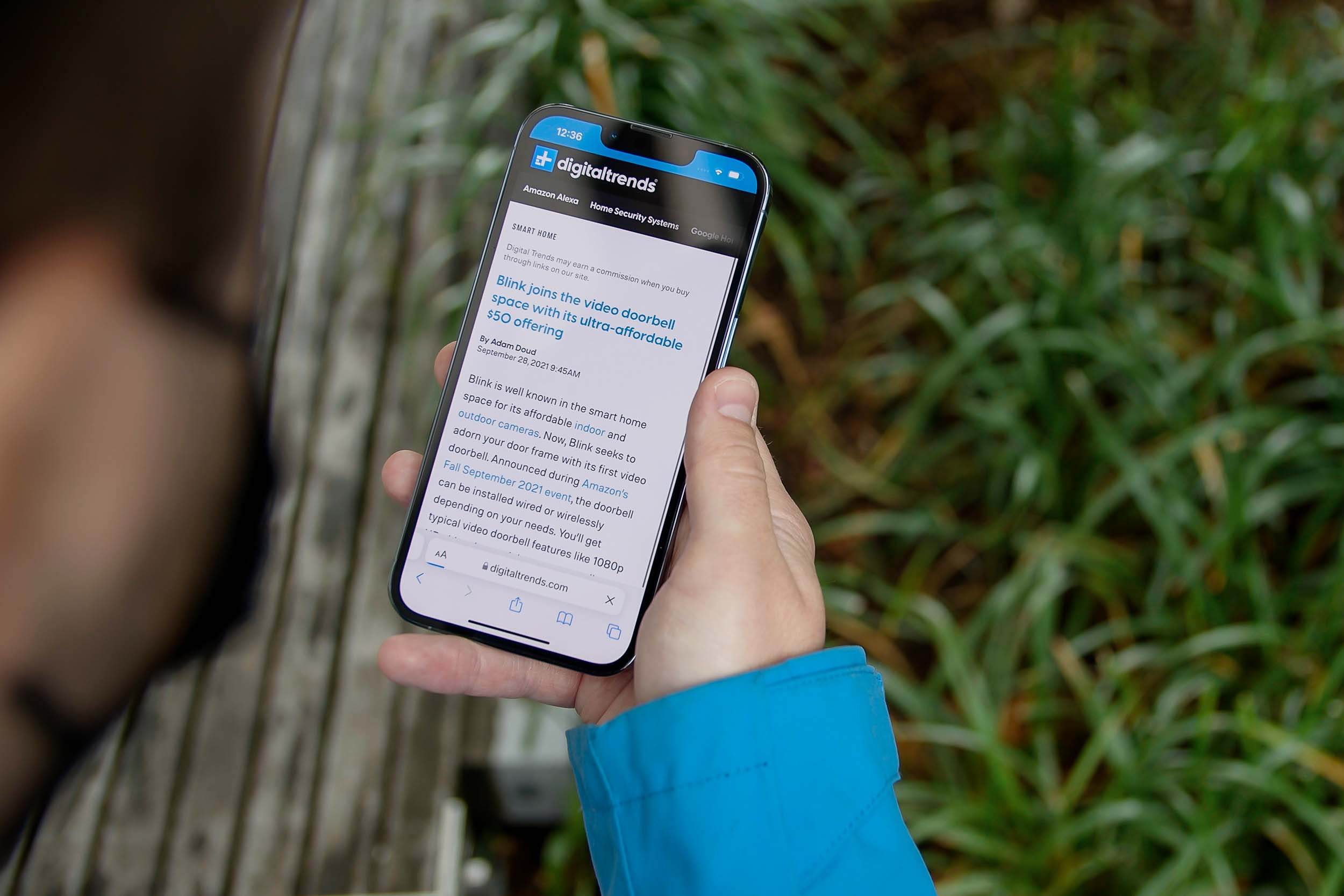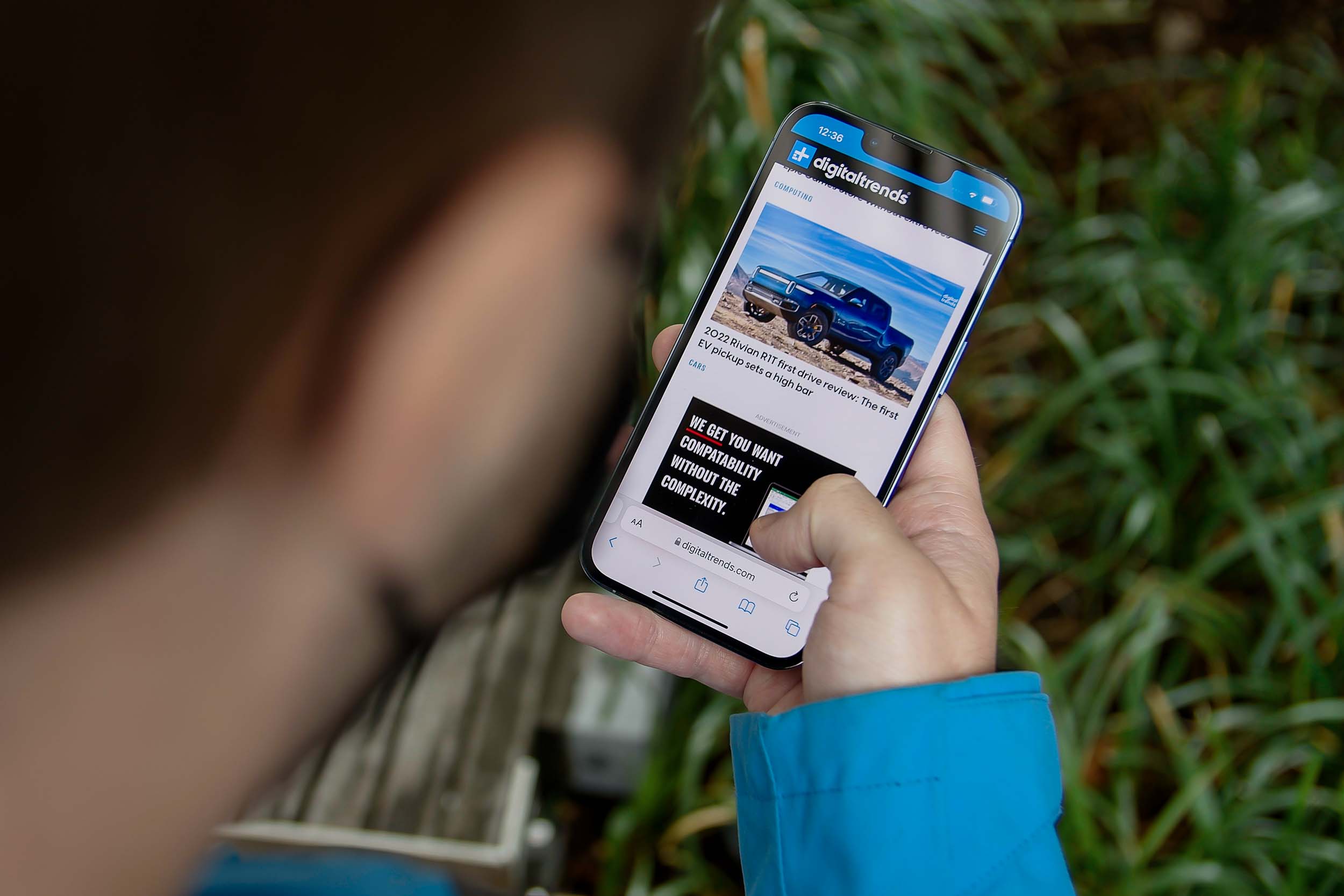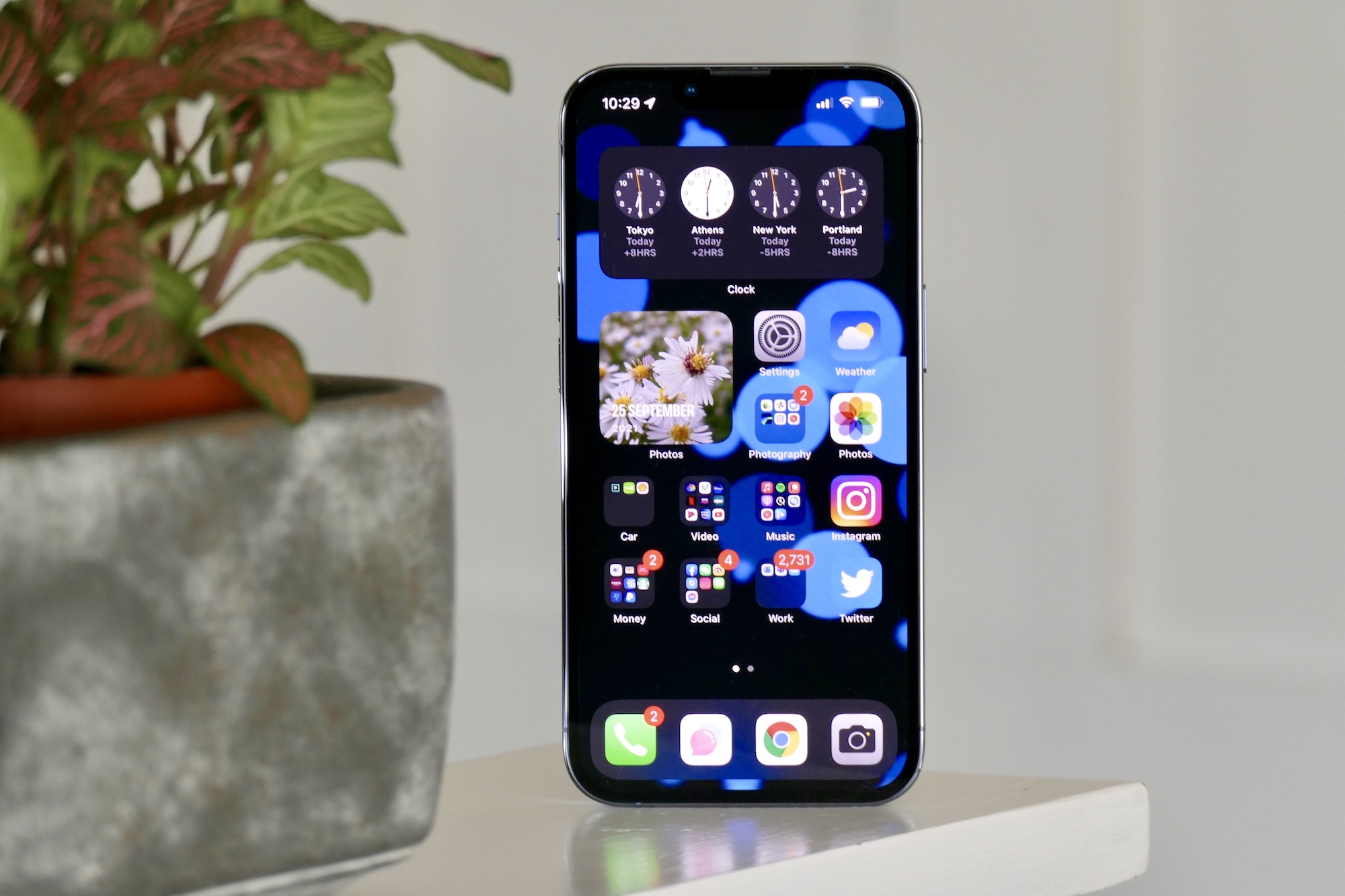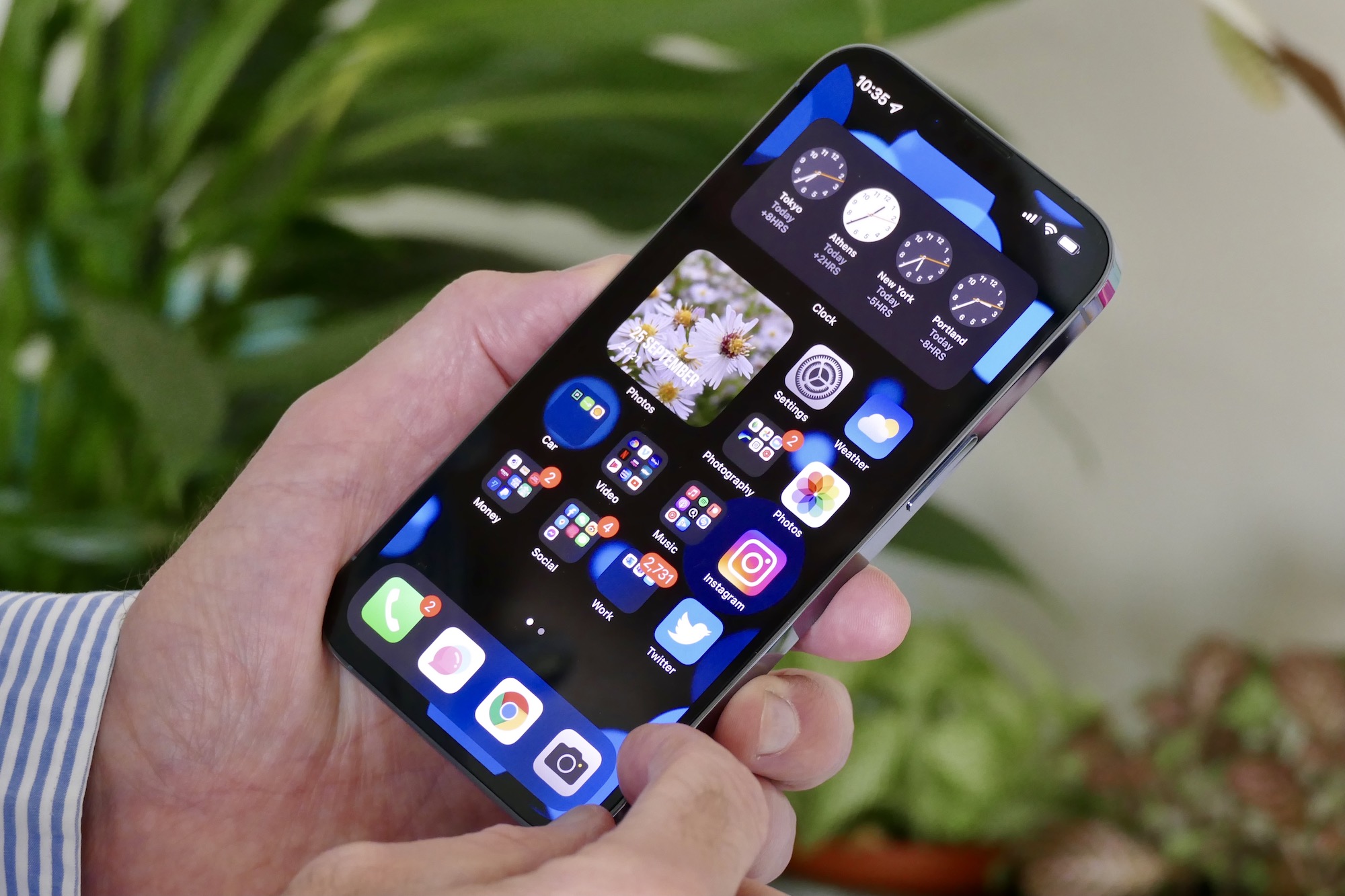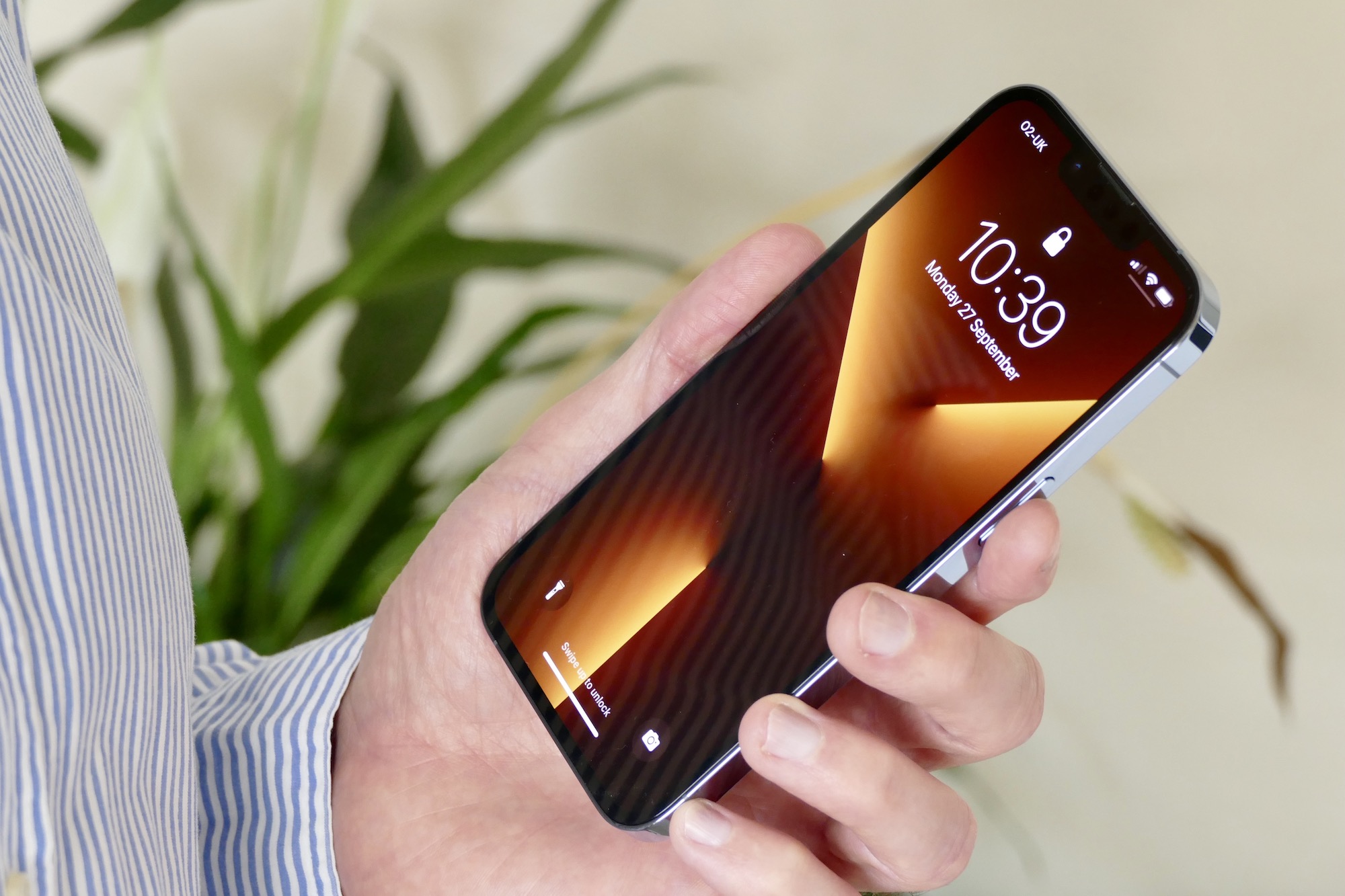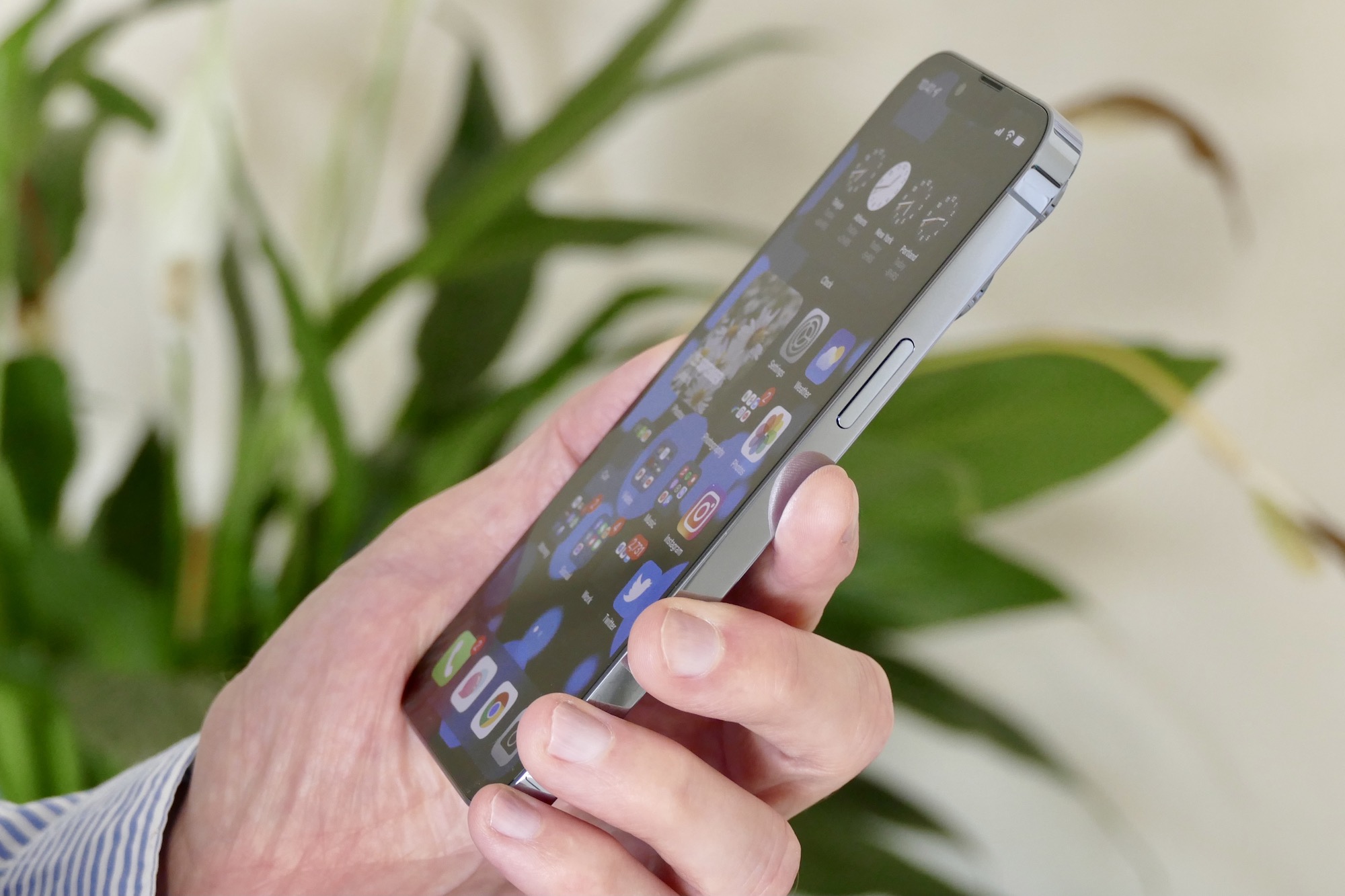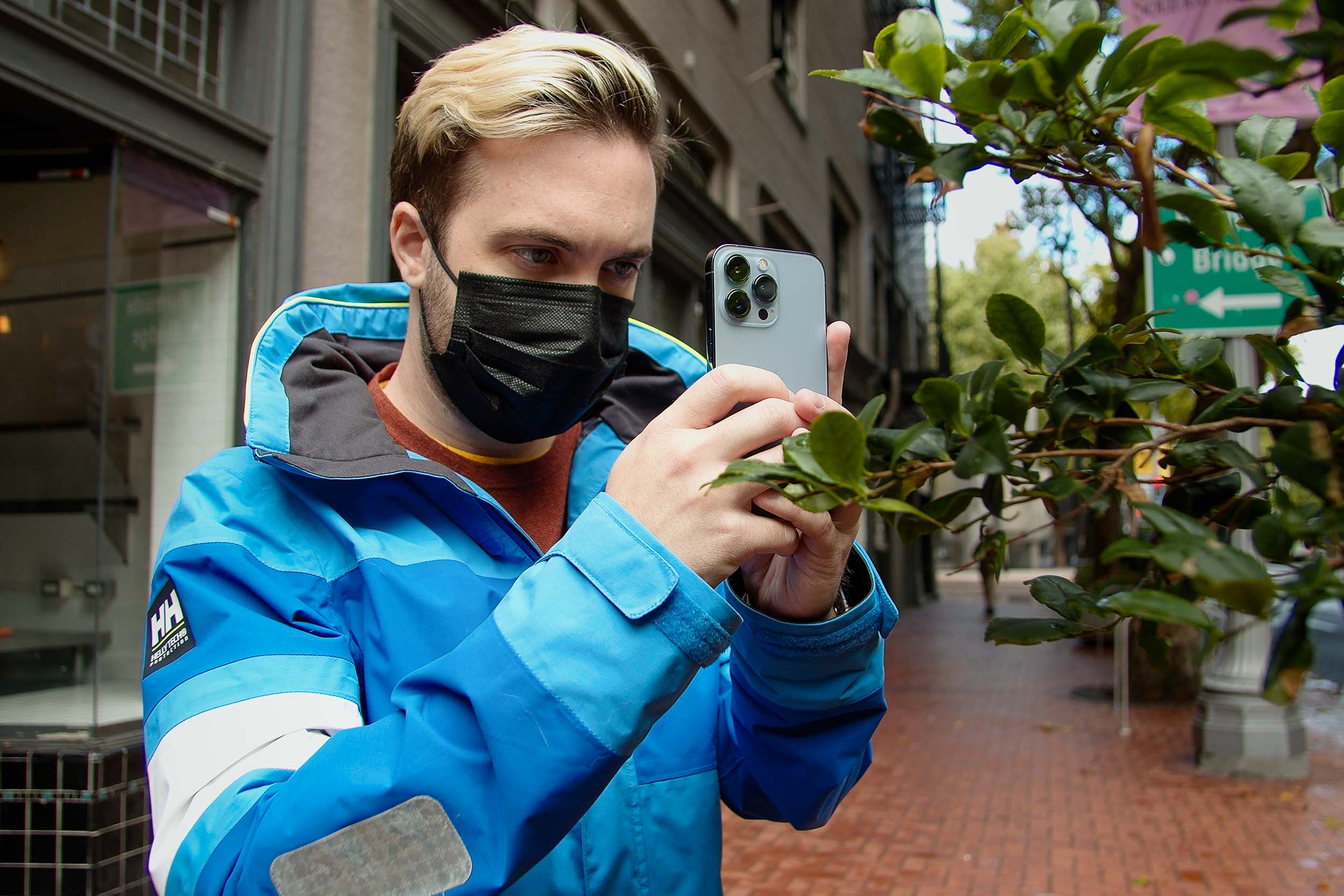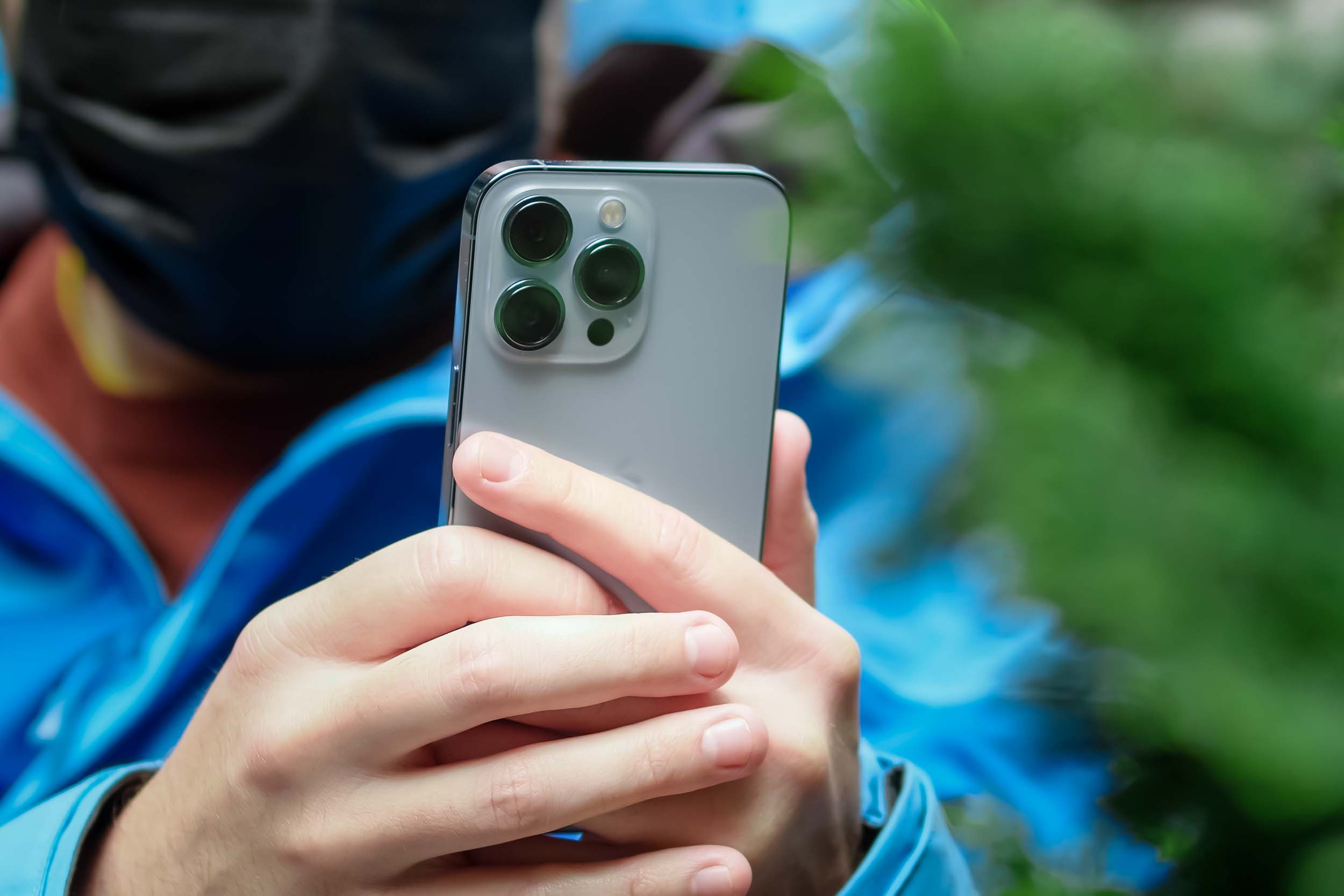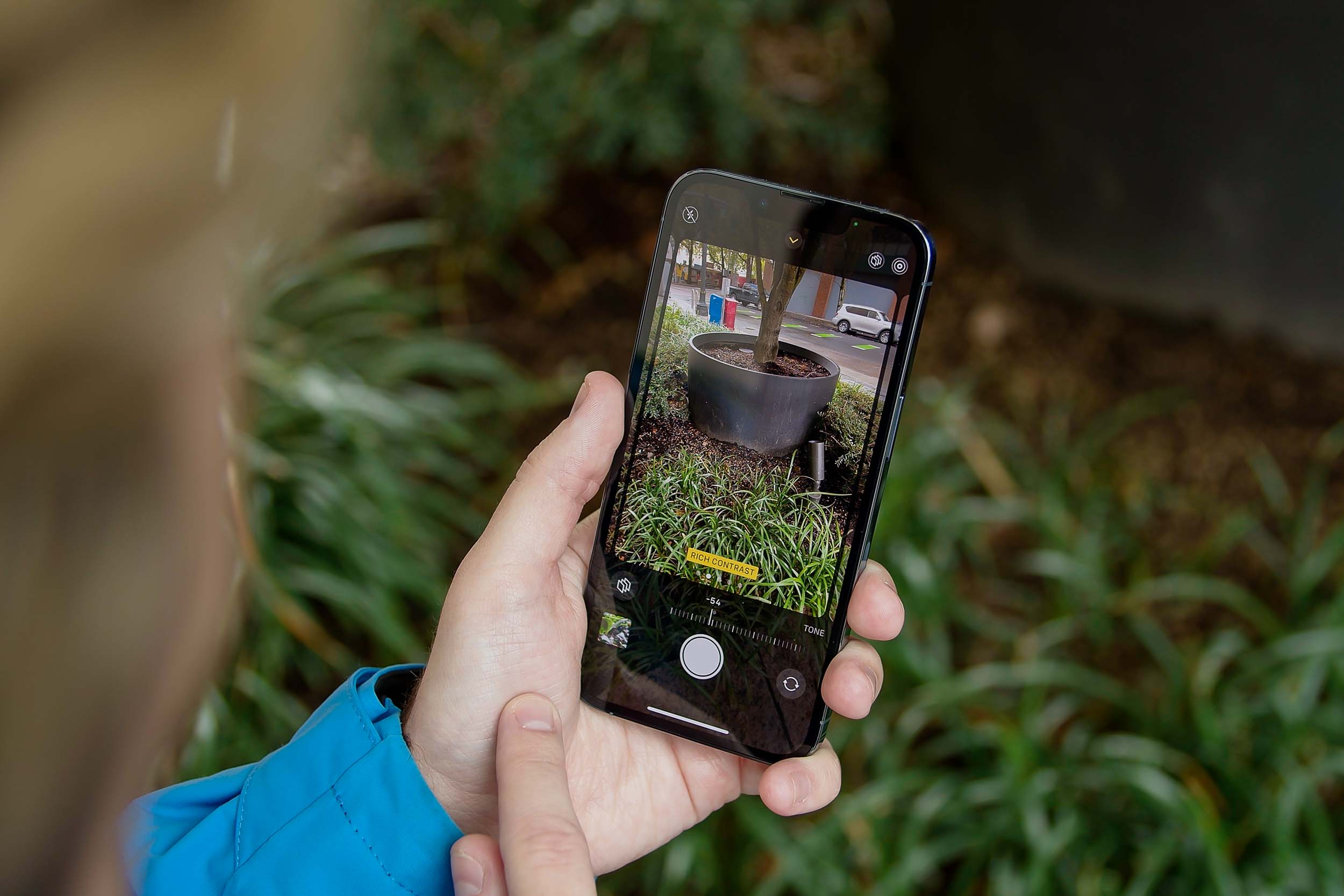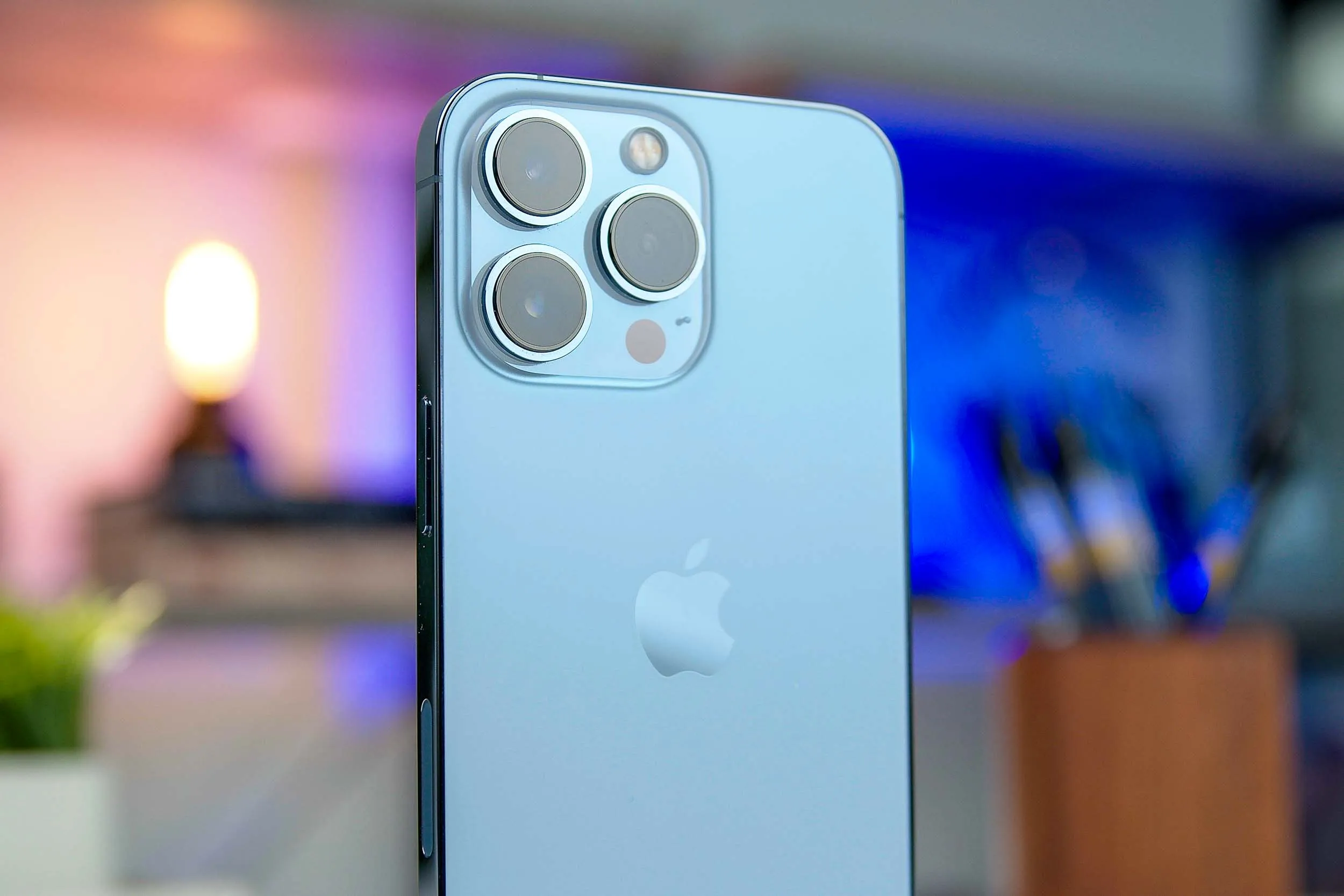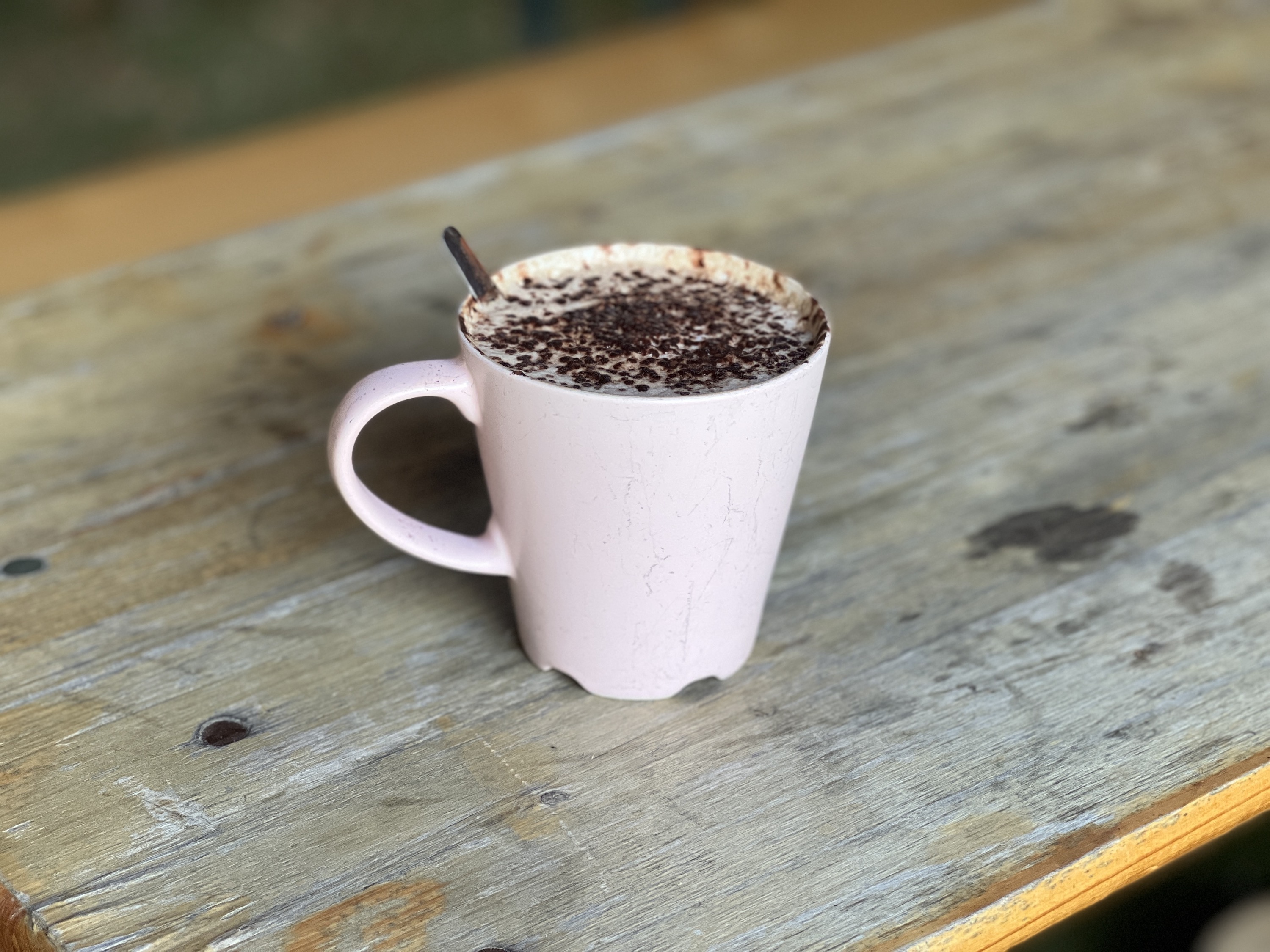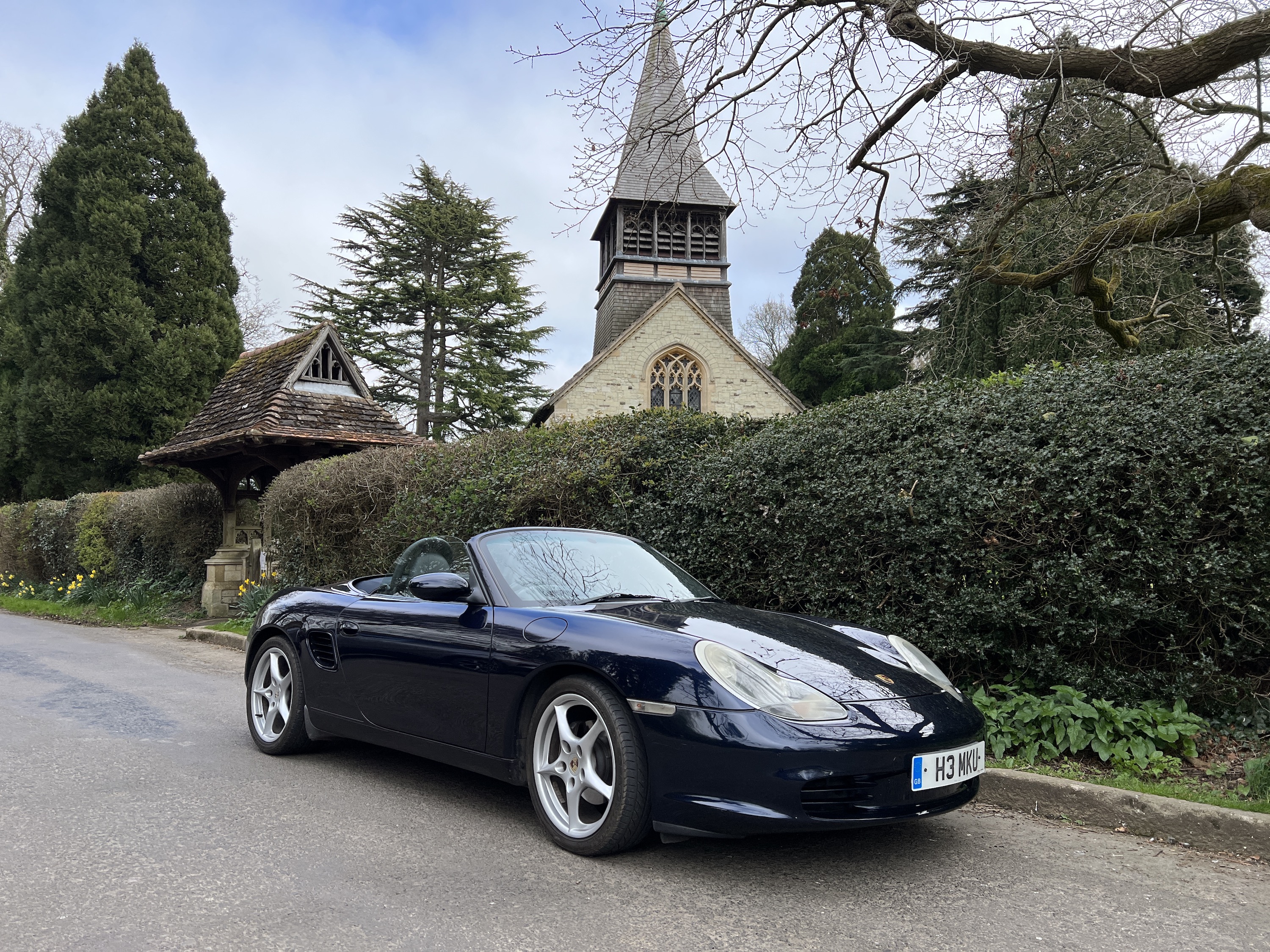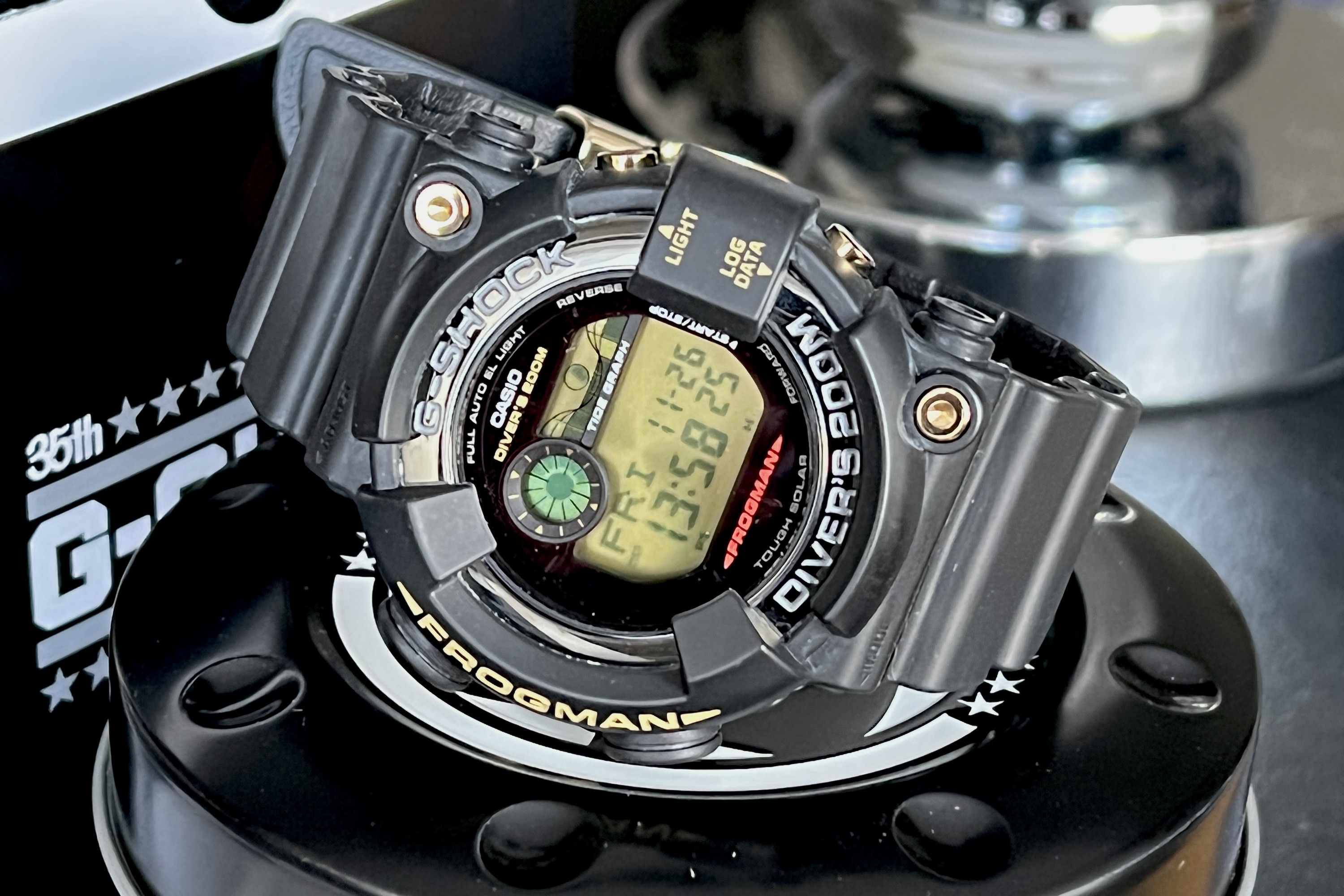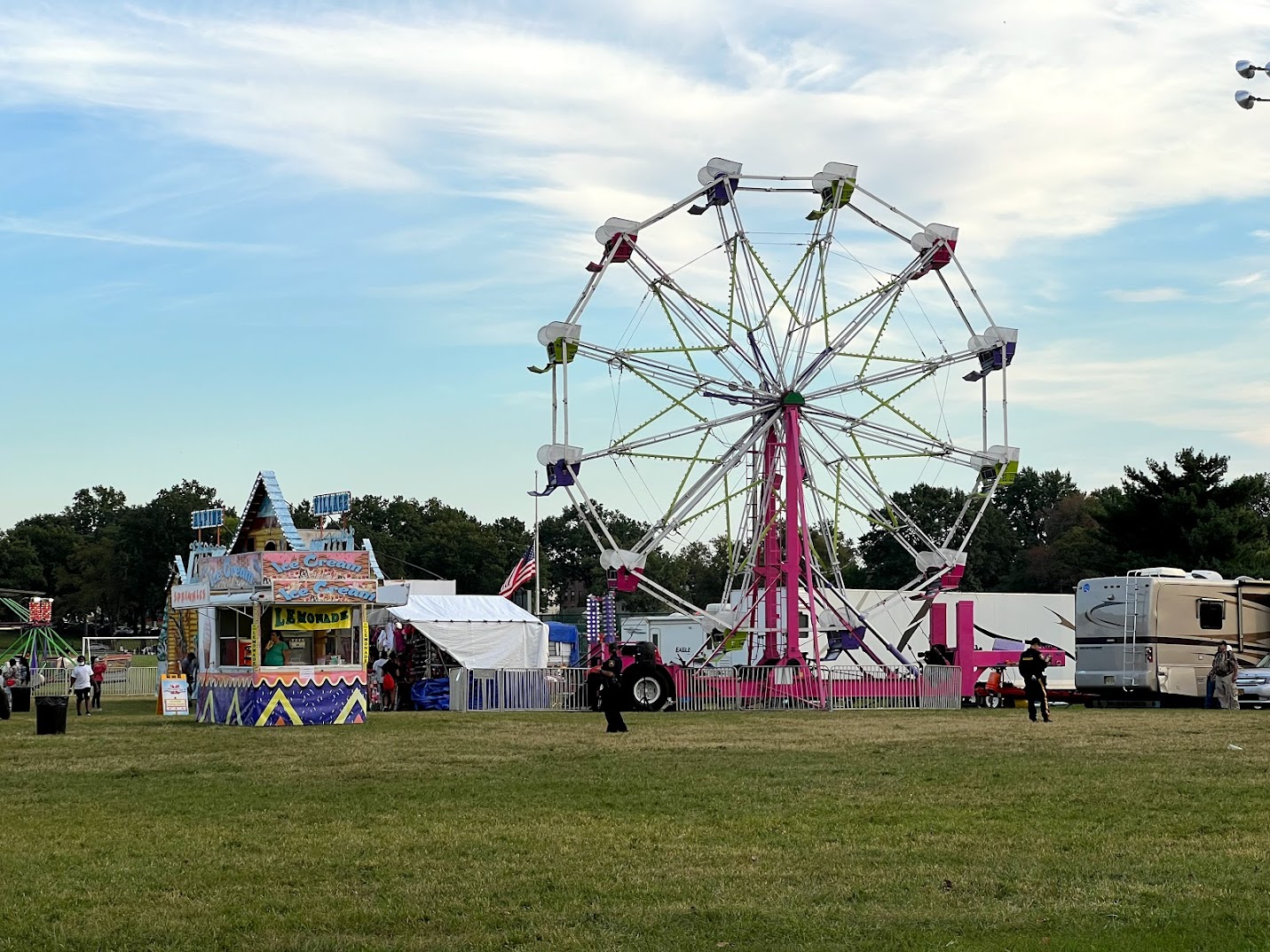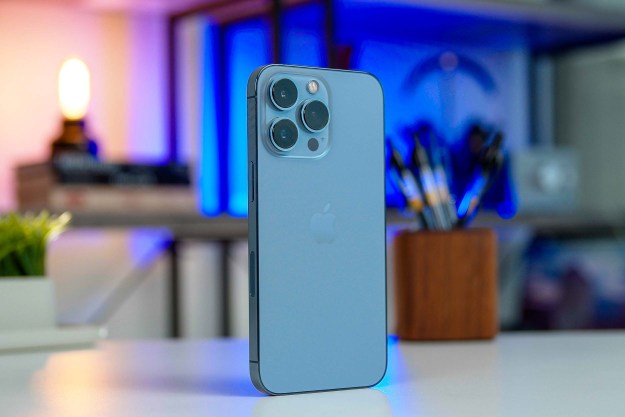
“The iPhone 13 Pro is the best model you can get in the lineup thanks to the 120Hz display, excellent camera, easy to use software, and two-day battery life.”
- Packs lots of power into its size
- Incredible camera and video performance
- Very long-lasting battery
- Smooth and responsive 120Hz screen
- Comes with 1TB storage option
- No fast charging
- No USB-C
Let’s get this out the way now: The iPhone 13 Pro is the new iPhone model you should buy. You’ll remember the iPhone 12 Pro Max had bigger camera sensors, giving it better lowlight performance and 3x optical zoom, rather than 2x. Not so this time. The iPhone 13 Pro is the same as the 13 Pro Max (aside from battery capacity and screen size, of course). so you don’t have to bust your hand or your wallet to get the top features.
Add into the mix the powerful A15 Bionic processor, 120Hz ProMotion display, battery life that can last almost two days, and excellent camera performance, and you have the best iPhone 13 model in the entire lineup. We’ve been using it since launch day, and have updated our review to reflect its performance many months into its life cycle.
Design
The iPhone 13 Pro comes in five different colors, including the Sierra Blue seen in our photos, along with Alpine Green, silver, gold, and graphite. Both the front and the back are protected by Apple’s Ceramic Shield glass, and a squared-off stainless steel strip runs along the sides, setting it apart in quality from the cheaper aluminum of the iPhone 13.
All the standard buttons are present including the Ring/Silent switch and volume buttons on the left and the power button on the right to activate Siri and toggle the screen on and off. There are also bottom-firing speakers on either side of the Lightning port. Yes, Apple has stuck to its proprietary Lightning port, which may frustrate those who own devices that use USB Type-C, including the iPad. There are rumors Apple may switch to USB Type-C for the 2023 iPhone.
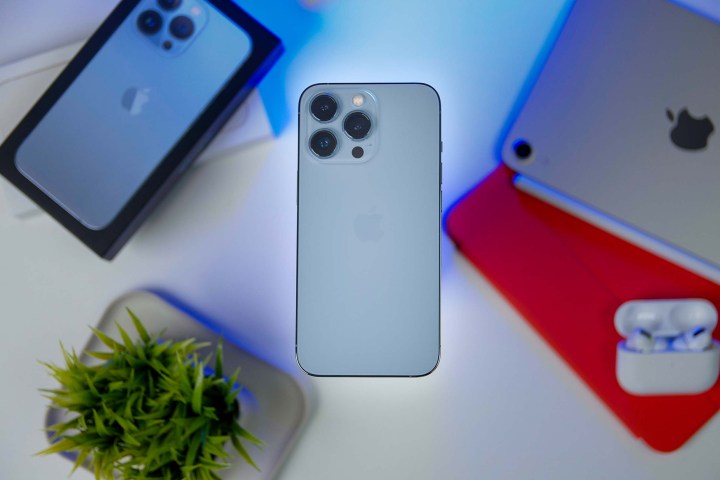
The iPhone 13 Pro is slim at 7.65mm, but quite heavy at 203 grams. This puts it in the same league as the Samsung Galaxy S22+, OnePlus 10 Pro, and its predecessor, the iPhone 12 Pro. The squared-off sides of the iPhone 13 Pro aren’t especially comfortable to grip, although the phone is usable with one hand. Using a case does improve the ergonomics. The relatively compact dimensions mean it easily slips into your pocket and goes unnoticed. If you choose the iPhone 13 Pro Max to get the larger screen, you will start pushing the limits of one-handed use.
Like all the other iPhone models, the iPhone 13 has IP68 dust and water resistance, along with a special glass Apple calls Ceramic Shield. It’s supposed to better protect the screen from scratches, which it seems to do well, but don’t expect it to avoid them completely. In our first week of testing, the screen picked up a gouge that was not really visible unless the light reflected on it. Eight months into ownership, our long-term iPhone 13 Pro has collected a variety of similar small scratches, likely coming from being put into pockets and bags. None affect visibility, and they’re only spotted when the screen is off. We still recommend a screen protector.
The notch at the top of the screen is 20% smaller than the notch on the iPhone 12 Pro, but because it’s also a bit deeper, this doesn’t mean the screen has a meaningful amount of extra usable screen real estate. Face ID unlocks the iPhone 13 Pro and it’s still the most secure face unlock system you’ll find on a phone, plus it’s highly accurate too. It works in almost all lighting conditions, at surprisingly varied angles, and through a recent iOS update, it operates when you’re wearing a face mask too.

On the back, the camera module is pretty similar in design to the iPhone 12 Pro. There’s a large, squarish camera housing with three cameras inside, but because each camera sensor is bigger this time, the camera bump protrudes from the back of the phone a bit more. It’s a fair trade-off for the improved camera performance. The overall design of the module has matured nicely, with the glass sections and stacked camera layout minimizing the visual impact.
The iPhone 13 Pro may not look drastically different from the iPhone 12 Pro, but the design has been refined and subtly improved, and it’s still one of the classiest phones you can buy. The build quality is superb, the materials used are proving durable over time, and the choice of colors gives the iPhone character.
Display
Of the many selling points for the iPhone 13 Pro, one of the biggest is the screen, and that doesn’t apply just to size. It’s a 6.1-inch Super Retina OLED screen with great color accuracy, a 2,532 x 1,170 resolution, and 460 pixels per inch (ppi) density. It’s sharp and bright, viewing angles are great, and it can hit 1,000 nits in brightness with a boost to 1,200 nits for HDR content. Outdoor visibility is excellent even in direct sunlight, and the screen also supports HDR10 and Dolby Vision.
That’s all fantastic, but what really sets it apart is the 120Hz ProMotion high refresh rate. ProMotion is a technology that first hit the iPad Pro series in 2017, letting Apple increase the refresh rate from the standard 60Hz to 120Hz for different kinds of content. This has become standard on Android flagship phones, but it’s a tech that Apple has been slow to adopt outside the iPad Pro, so it’s great to see it on both the iPhone 13 Pro and iPhone 13 Pro Max.
What’s particularly unique about Apple implementation of ProMotion is that the iPhone 13 Pro uses a low-temperature polycrystalline oxide (LTPO) panel, meaning that it’s able to dynamically vary the refresh rate from as low as 10Hz when doing something basic like browsing to up to 120Hz for something demanding like rapidly scrolling or gaming. This kind of implementation was first developed for the always-on screen of the Apple Watch to save battery life, and it has the same effect on the iPhone 13 Pro.
In actual usage, the ProMotion OLED screen is smooth and fantastic to use, and don’t let anyone tell you that you won’t notice the difference. When Apple released the iPad Air (5th generation) without a ProMotion screen ,we compared it to the ProMotion-equipped iPad Pro, and you don’t have to look hard to spot the differences. The smoothness is instantly noticeable, and long-term use is easier on your eyes. High refresh rate screens are common on Android smartphones, making it a very welcome addition on the iPhone.
After getting used to any high refresh rate screen, it’s hard to go back to a standard 60Hz refresh rate. Early on in the phone’s life, not all apps made use of the 120Hz refresh rate. However, we’re now months into the life of the iPhone 13 Pro and this has changed, with almost all top apps supporting the ProMotion screen. Video looks amazing on the phone too. Despite the flat glass over the screen, it doesn’t suffer from too many reflections, the colors are warm, it’s incredibly bright, and the high resolution shows plenty of detail. It’s a joy to look at, and the speakers are strong too, with almost no distortion even at higher volumes.
Performance, battery life, and connectivity
The iPhone 13 Pro has the latest and greatest A15 Bionic processor inside, and comes with 6GB RAM, along with a choice of various storage options, including 128GB, 256GB, 512GB, and 1TB. We recommend getting as much storage space as you can afford. If you run out, there’s no way to add more physical storage space to an iPhone, but you can pay for additional iCloud storage.
Performance is superb, regardless of what you do. It plays demanding games like Genshin Impact and Asphalt 9 without a problem, apps run smoothly and start immediately, the camera is always superfast, and animations throughout the operating system are faultless. Even after eight months, performance hasn’t diminished, and it easily keeps up with the very latest Android smartphones — and in many cases still surpasses them. The iPhone 13 Pro will handle everything you can throw at it, and then some.

Even with all its power and the large, bright screen, the iPhone 13 Pro’s 3,095mAh battery manages to keep up for a sensible amount of time. It’s not quite as strong as the iPhone 13 Pro Max, but it will happily last for a full day of hard use. Use it more sensibly — including the camera, music streaming, social networking, and other app use — and it will last two days.
Where it does suffer is when it switches between Wi-Fi, 4G, and 5G connectivity, and when you use it for power-intensive apps like GPS navigation. Put these two situations together and the battery can struggle to last a working day. The iPhone 13 Pro supports 5G, Ultra Wideband, sub-6GHz, and mmWave, plus dual-band Wi-Fi 6 and Bluetooth 5.0. Connection and signal have always been faultless.
As with all the other iPhone 13 models, the Pro is MagSafe compatible, supports 20-watt fast wired charging, 15W MagSafe charging, and 7.5W Qi wireless charging. Charging isn’t as fast as many Android smartphones, such as the OnePlus 10 Pro, and takes around 70 minutes with the optional 45W Apple fast charger. You don’t get a charger in the box, meaning if you use an older Apple charger or an alternative, charging times will likely be slower than this.
Cameras and video
The iPhone 13 Pro and the iPhone 13 Pro Max have the same camera system, and are an upgrade over the iPhone 13 and iPhone 13 Mini. You get three 12-megapixel sensors: A 12MP wide-angle, a 12MP telephoto, and a 12MP ultra-wide-angle camera that can take 120-degree field of view snaps. This camera array translates into truly incredible photo outcomes. The Camera app lets you set your preferred filter out of a choice of several, and all photos here were taken in Standard mode, which is most true to life.
Since the iPhone 13 Pro was released we have carried out a variety of camera comparisons, all of which give you a great idea of how the camera system performs. It easily beat the OnePlus 10 Pro, but it couldn’t quite match the Google Pixel 6 Pro, and although it also won against the Samsung Galaxy S22 Ultra, it was a very close battle. It was also close when put up against the older Samsung Galaxy S21 Ultra.
The biggest surprise was how it performed against the iPhone 12 Pro, where the older phone won against it. Although software updates seemed to have improved the 13 Pro’s camera over time, it still never quite reaches the heights of the 12 Pro’s excellent camera system. The iPhone 13 Pro’s camera takes more natural and slightly less immediately shareable photos in comparison. Editing the photos before sharing on social media is common when using the phone. Luckily, the iOS photo-editing suite is excellent, and packed full of features.
When we first tested the iPhone 13 Pro at launch, we noted how well the phone handled shots in direct sunlight. Blazing sun tends to be a big challenge for phones, even flagships, yet it doesn’t completely wash everything out or cast everything into shadow. Also worthy of praise is the detail in both the wide-angle and telephoto lenses. Apple’s software processing works hard throughout, and it’s impressive to see.
Aside from the 3x telephoto zoom, the other big new feature on the iPhone 13 Pro is macro photography. Normally, when you focus in close on an object, the phone loses focus and blurs out. It just can’t handle the focal length. The iPhone 13 Pro, on the other hand, can give you a very close focus on objects. The feature kicks in automatically and while the outcome doesn’t always work out, when it does, the results look great. Initially, there was no way to turn the feature off, resulting in the macro mode sometimes kicking in when you didn’t want it, but a toggle to disable the auto-switch has been added since.
The camera has several fun modes, including the 3x optical zoom, macro mode, Night mode, and Cinematic Mode for video. We have put them all to the test, and have also given the photo-editing mode a workout too. Night mode is very effective. It doesn’t brighten images so much that they look like daytime, and it manages to retain atmosphere while still revealing detail. Cinematic mode remains something we’ve only used for review. It’s technically very clever but feels like a gimmick, useful only for demonstrations or in very specific situations. The iPhone 13 Pro can shoot video at up to 4K resolution and at 24/30/60 frames per second (fps), or in 1080p at 30/60 fps.
Software and features
The iPhone 13 Pro comes with iOS 15, and we took a deeper dive into its individual features, but the notable ones include improved notification summaries, support for text scanning in the camera app, tabs for Safari, and future support for storing immunization records and other data.

Apple’s iOS software is among the easiest smartphone software platforms to learn, and one of the most reliable too. App compatibility is superb, with all major apps available for the platform and easily downloaded through the App Store. It doesn’t take long to set the phone up so it works quickly and logically, and while it’s not as customizable as Android, you can still make it your own.
Although we did encounter some bugs at launch, updates have refined iOS 15 since then and it runs mostly fault-free today. There are some odd problems though, but many will only be encountered in very specific situations. One enduring bug we face is when the Settings app crashes after connecting to a pair of AirPods, requiring the app to be manually closed twice before it works again. This aside, the seamless way iOS integrates with an Apple ecosystem of products — from the Mac Mini to the Apple TV and AirPods Max — is a massive benefit, and one that still can’t be matched for simplicity elsewhere.
Price and availability
The iPhone 13 Pro starts at $999 for the 128GB version, but you will pay more for additional storage. To get 256GB you’ll pay $1,099, or $1,299 for 512GB. The largest 1TB iPhone 13 Pro costs $1,499. If you decide you want the larger iPhone 13 Pro Max, add $100 to all these prices.
Our take
Even though it launched in 2021 and is now many months into its life cycle, the iPhone 13 Pro remains the modern iPhone to buy, due to it being technically identical to the bigger iPhone 13 Pro Max, but in a more manageable package for a lower price. The same positives we listed at launch still apply. The 120Hz ProMotion screen is a standout feature, the battery returns two days of use on a single charge, iOS 15 has been continually updated and improved, and the camera is capable and feature-packed.
Most of all, the iPhone 13 Pro is hugely reliable. Whether streaming music, watching video, taking photos, sharing documents with MacOS, printing through a wireless printer, using Bluetooth headphones, sending messages, using Zoom, or practically any smartphone-related task you can think of, the iPhone 13 Pro will easily and effortlessly handle them all.
Add in that it’s beautifully made, is compatible with the best smartwatch you can buy, has a massive third-party ecosystem of accessories, and retains a lot of value when the time comes to upgrade, and the iPhone 13 Pro is one of the wisest, safest consumer tech purchases you can make today.
Is there a better alternative?
In terms of hardware, the iPhone 13 Pro is the best model in the lineup, but if you want a longer-lasting battery and a bigger screen, the iPhone 13 Pro Max has everything in the Pro for a higher price. The iPhone 13 is more affordable, but it’s pared-down with no 120Hz screen, telephoto lens, or support for macro photos. It also doesn’t have a 1TB storage option. The iPhone 13 Mini is an even smaller version with the same hardware, making it a good choice if you love small phones.
If you aren’t set on an iPhone, the Android-powered Samsung Galaxy S22 Ultra, OnePlus 10 Pro, and the Google Pixel 6 Pro all give the iPhone 13 Pro serious competition. The Samsung Galaxy Z Fold 3 may also be worth a look if you like the idea of trying out a folding smartphone.
What if you have an older iPhone? If you own the iPhone 12 Pro, then we’d recommend sticking with it for now. The iPhone 13 Pro performs in a very similar way, and we’d say the camera is actually slightly better. If you own an iPhone 11 Pro or earlier, then the iPhone 13 Pro is a significant upgrade due to the high refresh rate screen, camera, and faster processor.
How long will it last?
The standard warranty for the iPhone 13 Pro is one year, but you can get Apple Care+ to extend it for two to three years and cover two instances of accidental damage every 12 months. The phone is also IP68 water and dust resistant, letting it survive full immersion and rinsing in the sink. Apple doesn’t state how long its software update commitment is, but based on existing models, it will still receive the latest version of iOS in four of five years time. If you’re a power user, the iPhone 13 Pro should still last for three years at the absolute minimum.
Should you buy it?
Yes. There’s no question that the iPhone 13 Pro is the best model in the latest lineup, and one of the very best smartphones available today.
Editors' Recommendations
- iPhone 16: news, rumored price, release date, and more
- 10 iPhone productivity apps you need to download right now
- Best iPad deals: Save on iPad Air, iPad Pro, iPad Mini for the New Year
- Apple accidentally revealed a big iPad Pro display upgrade
- The best iPhone 15 Pro Max cases in 2024: the 20 best ones


